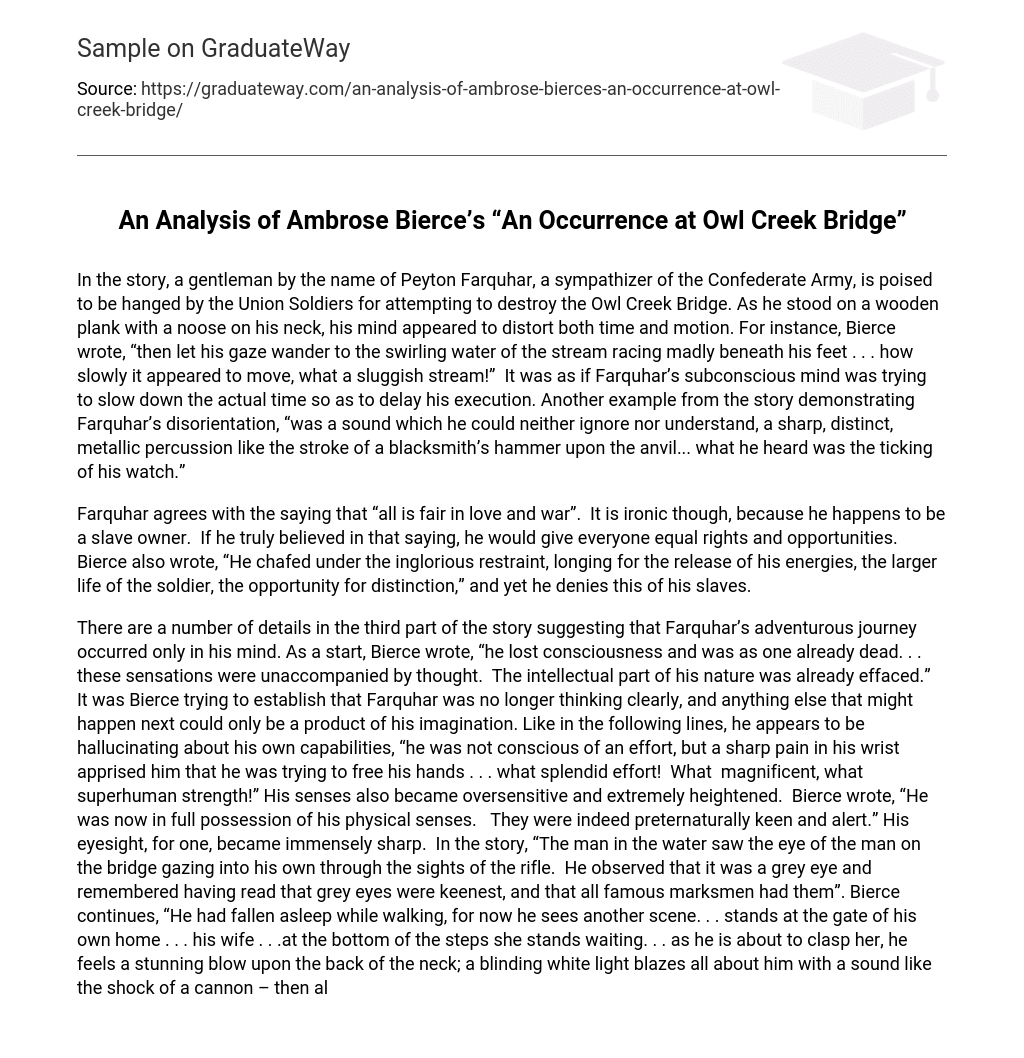Have you ever considered the fragility of reality when confronted with imminent demise? Ambrose Bierce’s “An Occurrence at Owl Creek Bridge” masterfully explores this question. However, dissecting its intricate narrative structure and thematic complexity presents a considerable challenge, one that demands a meticulous examination of its psychological depth and literary prowess. This necessitates a granular approach to unravel the story’s multifaceted layers.
I. A Bridge Between Worlds: Setting the Stage
The story commences with a stark and unsettling image: a man, Peyton Farquhar, stands on a railroad bridge, a noose around his neck. He is about to be hanged. This grim tableau, rendered with almost photographic precision, immediately plunges the reader into a palpable atmosphere of dread and anticipation. The setting, Owl Creek Bridge, becomes more than just a physical location; it metamorphoses into a liminal space, a threshold between life and death, reality and illusion. The meticulous description of the surrounding landscape, punctuated by the cold, detached observation of the soldiers, further amplifies the unsettling mood. Bierce’s prose, even in these initial paragraphs, is imbued with a clinical detachment, a characteristic that underscores the story’s exploration of the psychological effects of trauma and the disorienting nature of near-death experiences.
II. The Cadence of Condemnation: Structure and Narrative Disjunction
Bierce employs a non-linear narrative structure, deliberately fragmenting the chronology of events to mirror the protagonist’s increasingly fractured mental state. The story unfolds in three distinct sections. Part I establishes the scene, presenting Farquhar’s impending execution. Part II offers a flashback, revealing Farquhar’s motivations and the circumstances that led to his capture. Part III chronicles his imagined escape, a flight from the gallows that grows increasingly surreal and improbable. This fractured narrative structure is not merely a stylistic choice; it is a deliberate strategy to disorient the reader, mirroring Farquhar’s own disorientation as he confronts the prospect of death. The abrupt shifts in perspective and the juxtaposition of reality and fantasy further contribute to the story’s overall sense of unease and ambiguity.
III. A Confederate’s Contemplation: Exploring Themes of War and Illusion
“An Occurrence at Owl Creek Bridge” delves into profound themes, notably the illusory nature of reality and the psychological impact of war. Farquhar, a Southern planter and fervent supporter of the Confederacy, is portrayed as a man driven by romantic notions of heroism and valor. His eagerness to contribute to the war effort, however misguided, stems from a deep-seated desire to prove his worth and defend his ideals. This patriotic fervor, however, blinds him to the brutal realities of war. His imagined escape becomes a powerful allegory for the human desire to escape suffering and death, even if only in the realm of fantasy. The story ultimately suggests that war not only destroys lives but also shatters illusions, leaving behind a landscape of shattered dreams and unfulfilled potential. The psychological toll is undeniable.
IV. The River’s Reflection: Symbolism and Foreshadowing
Bierce masterfully employs symbolism and foreshadowing to enhance the story’s thematic resonance. The Owl Creek Bridge itself functions as a potent symbol of transition and mortality, representing the precarious boundary between life and death. The river, with its relentless current, symbolizes the inexorable passage of time and the futility of resisting fate. Throughout the narrative, subtle clues foreshadow Farquhar’s ultimate demise. The abnormally heightened senses he experiences during his imagined escape, the distorted perception of time, and the increasingly surreal nature of his surroundings all hint at the fact that his escape is nothing more than a desperate delusion. These subtle cues, artfully woven into the fabric of the narrative, contribute to the story’s overall sense of inevitability and tragic irony.
V. The Unraveling of Reality: Psychological Realism and Subjective Experience
One of the most striking aspects of “An Occurrence at Owl Creek Bridge” is its exploration of psychological realism. Bierce delves into the inner workings of Farquhar’s mind, meticulously depicting the distorted perceptions and hallucinatory experiences that accompany the near-death state. The story blurs the boundaries between objective reality and subjective experience, inviting the reader to question the reliability of perception and the nature of consciousness. Farquhar’s heightened senses, his distorted perception of time, and his increasingly fantastical visions are all rendered with a chilling verisimilitude, lending credence to the idea that his escape is a product of his own desperate imagination. This exploration of the psychological landscape of death anticipates later developments in modernist literature, solidifying Bierce’s reputation as a pioneer of psychological fiction.
VI. Bierce’s Bitter Brew: Irony and Fatalism
Irony permeates “An Occurrence at Owl Creek Bridge,” contributing to its overall sense of fatalism and disillusionment. Farquhar’s desperate attempt to sabotage the bridge, motivated by a desire to serve the Confederate cause, ultimately leads to his own demise. His imagined escape, a fleeting moment of triumph and hope, is revealed to be nothing more than a cruel illusion, a final act of self-deception before the inevitable plunge into oblivion. The story’s ironic twist underscores the futility of human endeavor in the face of fate and the ultimately meaningless nature of war. Bierce’s bleak worldview, informed by his own experiences as a soldier in the Civil War, is evident in the story’s pessimistic tone and its unflinching portrayal of human suffering.
VII. Echoes in Eternity: Lasting Legacy and Influence
“An Occurrence at Owl Creek Bridge” remains a seminal work of American literature, renowned for its innovative narrative structure, its exploration of psychological realism, and its profound thematic resonance. The story’s influence can be seen in countless works of literature and film that explore themes of war, illusion, and the subjective nature of reality. Its enduring popularity is a testament to Bierce’s masterful storytelling and his ability to capture the psychological complexities of the human experience. The story continues to resonate with readers today, prompting reflection on the fragility of life, the power of the imagination, and the enduring legacy of war. Its impact is irrefutable and lasting.
